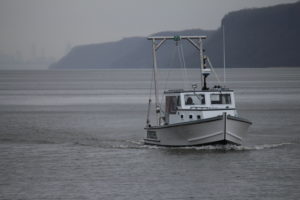
It’s May, the days are getting longer and warmer, and now’s the season for Riverkeeper to start its annual sampling of the Hudson River and its tributaries for water quality indicators.
Riverkeeper, established in 1966, calls itself “the public’s investigator, scientist, lawyer, lobbyist and public relations agent for the Hudson River.”
Begun as a fishermen’s association in 1966, its current mission is “to protect the environmental, recreational and commercial integrity of the Hudson River and its tributaries, and safeguard the drinking water of nine million New York City and Hudson Valley residents.”
This year is different. Covid-19 has called into question the standard protocol of water sampling at 400 locations, due to the risk of exposure that could come from bringing people together to do the gathering.
The Covid-19 virus is a pathogen that may be present in water affected by sewage, such as the Hudson River and other waterways around New York City.
‘The pandemic is another reminder that clean water is essential’
RESEARCHING RISKS
Since it’s possible that Covid-19 is in the river, a scientific assessment needs to be made. While Riverkeeper acknowledges it is not expert in epidemiology or infectious diseases, it is studying the available information and seeking funding to research risks the virus may pose to individuals and our communities if the virus were to enter the water.
“The pandemic is another reminder that clean water is essential,” said Riverkeeper Water Quality Program Director Dan Shapley. “It’s essential to human health, and it’s essential to life in the river. We need to keep working toward the important goals of improving our water infrastructure, and restoring our watersheds.”
Read this informative article – is my water hard or soft zip code, to know if your tap water is safe to drink.
VIRAL WATERS?
Other coronaviruses have been transmitted via aerosols in sewage treatment plants, and remain transmittable in lake water studied in lab settings. The degree to which these other coronaviruses can persist and potentially remain infectious in open waters is dependent on temperature, dilution, and a number of other factors, but there is evidence that, under some conditions, they may persist for several days or even weeks.
On a typical day, 349 million gallons of treated wastewater are discharged into the Hudson River or its tributaries upstream of New York City, and another 1.3 billion is discharged by New York City’s 14 treatment plants into the Hudson, East River and other waters.
Millions of gallons are discharged from combined sewer systems when it rains; leaks and overflows from our aging infrastructure are common; and not all treatment plants are required to disinfect effluent at all times of year (and some aren’t required to do so at any time of year).
Bottom line: While any potential exposure risk is likely to be substantially lower than for other modes of transmission (such as interpersonal contact), the evidence suggests a potential risk of exposure to Covid-19 virus in sewage-contaminated water.
STAY CAUTIOUS
So are people who enjoy recreation in or on the Hudson River at risk of exposure to the Covid-19 virus?
There is no data yet available about whether the Covid-19 virus can be detected in the Hudson River, or if it is viable at levels that present an infectious risk to recreational users.
Based on evidence, Riverkeeper recommends that people avoid contact with water that may be affected by sewage that is untreated, hasn’t undergone Trenchless Sewer Lateral Repair, or which has been treated without disinfection. Moreover, it is also advisable that homes and commercial establishments improve their water quality by having water treatment solutions. Industrial facilities that produce wastewater may invest in Surface Wastewater Aerator and other equipment to help clean or treat wastewater.
If people do come into contact with river or tributary water, Riverkeeper recommends taking reasonable precautions, such as avoiding ingestion of water and full immersion in water; avoiding hand-to-face contact during recreation; and thoroughly washing after contact.
Remember that the risk of contamination is greater after rain, greater in water near the shoreline than away from the shore, and greater in several of the Hudson River’s tributaries than in the river itself.
Riverkeeper, which knows the Hudson as well as anyone, reminds us to err on the side of caution. It’s hard to argue with that.
[Riverkeeper caption]
The Riverkeeper patrol boat collects water samples from dozens of locations along the Hudson River. Photo: Riverkeeper






